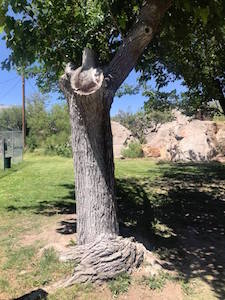 Girdling roots on this mulberry tree in Truth or Consequences may be the underlying problem causing canopy dieback no matter how much extra water is applied. (Photo credit M. Thompson)Question: The Texas red oak, live oak, and pecan trees in my yard were looking bad going into the fall, as were my neighbor’s honey locust and maple. When I searched for problems online, I found different possible pests and diseases for each tree. Can you help me narrow down the possibilities?
Girdling roots on this mulberry tree in Truth or Consequences may be the underlying problem causing canopy dieback no matter how much extra water is applied. (Photo credit M. Thompson)Question: The Texas red oak, live oak, and pecan trees in my yard were looking bad going into the fall, as were my neighbor’s honey locust and maple. When I searched for problems online, I found different possible pests and diseases for each tree. Can you help me narrow down the possibilities?
Richard V., Hobbs, NM
Answer: Local tree experts agree that the number one tree “disease” in New Mexico is drought. And the number one pest for trees in New Mexico is humans with our weed whackers and mowers.
That being said, last summer over the phone with the Hidalgo County Extension Agent, I diagnosed Afghan pines with water stress. Luckily for those poor trees, I had a trip planned to visit Lordsburg that month, so we scheduled a site visit, and though the problem was technically water stress, it wasn’t what I expected. The homeowner’s soil was heavy clay, and the roots were staying way too wet.
Roots need water, that’s for certain. But it’s also true that they need oxygen, so before anyone waters their trees (along with all your other landscape plants), stick your finger in the soil or use a tool to dig down a few inches. If the soil feels moist, don’t water quite yet.
Roots also need space to grow. The rules differ by tree species and soil type, but the larger the tree trunk and canopy, generally, the larger the root zone needs to be. The International Society of Arboriculture defines the critical root zone (aka critical root radius) for a given tree as the area equal to a 1-foot radius from the trunk base for every 1 inch of trunk diameter. Trunk diameter measurements should be taken at 4.5 feet above ground (or thereabouts, depending on tree age and whether there are huge, knobby lumps in the trunk). As I mentioned back in June, the quickest way for me to estimate tree trunk girth without a measuring tape is to visualize a whole pizza that’s the same size as the trunk diameter—personal pan pizzas tend to be 6 inches and a large pizza is usually around 15 inches. So, if your tree trunk is a medium pizza size, you can guestimate that the trunk is 12 inches in diameter and translates to an approximate 12-foot rooting radius. That’s a 24-foot diameter of rooting area for a model tree to have room to breathe, but in order for the tree to continue to grow without failing, it will need even more space.
This equation also comes in handy when you’re selecting a tree for a small patch of ground or a courtyard. If you only have a space that’s 10 feet by 10 feet, the rooting radius is only 5 feet, and that means the area will only support a tree whose trunk gets up to 5 inches in diameter at maturity! No wonder trees fail in small spaces like medians and hell strips. (Hell strips are the aptly-named, narrow patches between sidewalks and roadways.)
These are rules of green thumb, but there are, of course, exceptions. And yes, when trees are young and small, they can be pretty and healthy, even in tiny spaces. But if you want to grow a healthy, mature tree sustainably, remember the arborist’s mantra: Right tree, right place. Selecting smaller trees like crepe myrtles, dwarf fruit trees, or redbuds makes more sense for small areas in the long run. Stressing plants by limiting root area is a sure way to invite secondary problems like pests and diseases.
As for these landscape trees in Hobbs, I have more questions than answers. Details like tree age, soil texture and area, and irrigation and fertilization practices are necessary in order to diagnose tree problems. Even then, an accurate diagnosis may not be possible.
Symptoms are often insufficient for conclusive diagnosis. Symptoms can change over time. Or they may point to the secondary problem while the underlying problem (like water stress) remains hidden. Next week I’ll get more into the steps for diagnosing tree disorders. For now, I recommend we all go outside, touch a tree, and act as detectives. What’s wrong (or could go wrong) with this beautiful plant? Be careful not to jump to conclusions. One time I searched symptoms for my own ailments and Google said I likely had Dutch elm disease.
For more gardening information, including decades of archived Southwest Yard & Garden columns, visit the NMSU Extension Horticulture page or contact your County Extension office.
Marisa Thompson, PhD, is the Extension Horticulture Specialist for New Mexico State University and is based at the Agricultural Science Center at Los Lunas.